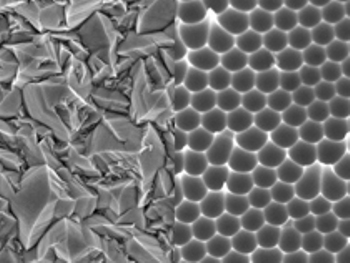The École polytechnique fédérale de Lausanne (EPFL) research team has designed a novel nanopatterning technique to improve the output of ultra-thin solar cells, when compared to traditional solar cells.
 Layers of zinc oxide seen through an electron microscope
Layers of zinc oxide seen through an electron microscope
If the cells are thinner, they trap minimum sun rays, which in turn results in less production of electricity. Thus, the scientists are working on capturing light in thin silicon layers to improve their absorption. Usually, thin zinc oxide layers, which develop as tiny pyramid-shaped crystals, are utilized for this application. These crystals disperse light effectively into the core silicon layer. Solar cells using these zinc oxide layers have already achieved world record efficiency.
However, the EPFL researchers are trying to break this record. The research team led by Christophe Ballif of the EPFL’s Photovoltaics and the Thin-Film Electronics Laboratory has been involved in the research on thin-film silicon solar cells. The Federal Office of Energy and the Swiss National Science Foundation are backing the research.
Corsin Battaglia, one of the researchers, stated that it is not easy to alter the normal pyramidal form of these crystals to achieve enhanced light scattering. Hence, the researchers used an innovative but simple idea that forced the crystals to develop on an inverted mold with the preferred structure, Battaglia said. After the deposition of the zinc oxide thin layer on the mold, it should be demolded to obtain a film with the preferred structure.
This novel method not only enhances the solar cells output by trapping more amount of light but also decreases the production costs due to its suitability with volume production.